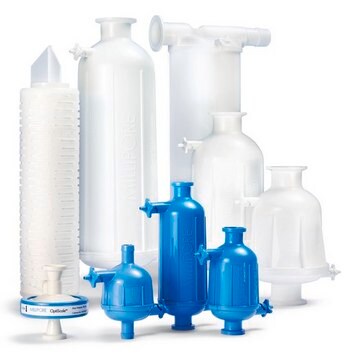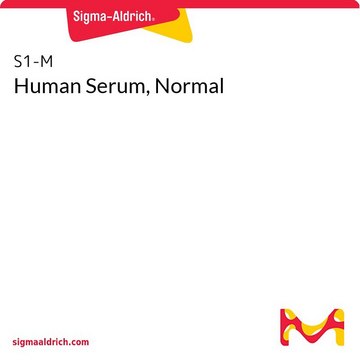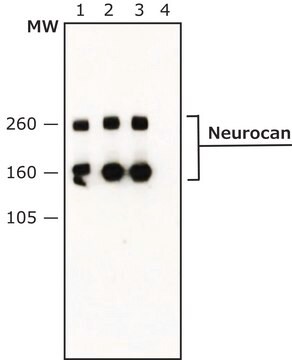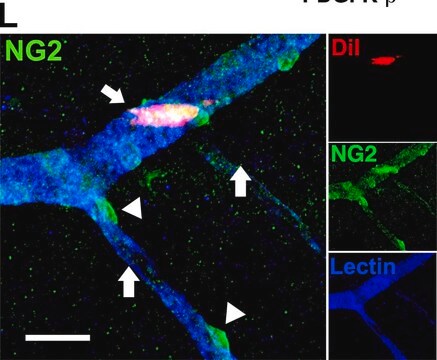MAB5234
Anti-Neurocan Antibody
Chemicon®, from mouse
About This Item
Produits recommandés
Source biologique
mouse
Niveau de qualité
Forme d'anticorps
purified immunoglobulin
Type de produit anticorps
primary antibodies
Clone
monoclonal
Espèces réactives
chicken
Fabricant/nom de marque
Chemicon®
Technique(s)
ELISA: suitable
immunoprecipitation (IP): suitable
western blot: suitable
Isotype
IgG1
Numéro d'accès NCBI
Numéro d'accès UniProt
Conditions d'expédition
dry ice
Modification post-traductionnelle de la cible
unmodified
Informations sur le gène
human ... NCAN(1463)
Description générale
Spécificité
Application
Western blot using anti-chick Neurocan (MAB5234). Samples are 1) Untreated embryonic chick brain extract, 2) chondroitinase-treated embryonic chick brain extract, 3) GST fusion proteins from the middle region of chick neurocan.
Samples must be digested with chondroitinase prior to running on SDS gels because undigested phosphacan is too large for most gels. Treatment is at a concentration of chondroitinase of 10U/mL in Tris-HCL pH 8.0. Make tissue or cell extract in 20-50mM Tris pH 7.6-8.0 with 0.15M NaCl in the presence of protease inhibitors. Add 1 microliter of enzyme to 30 microliters of extract and incubate 30 minutes at 37C. Then add SDS sample buffer, heat or boil sample as normal for SDS reducing samples.
Immunoprecipitation: 1 μg/mL
ELISA: 1 μg/mL, excellent for core protein, good for monomer
Immunocytochemistry: not tested
Immunohistochemistry: does not work on fixed samples, unfixed has not been tested.
Optimal working dilutions must be determined by the end user.
Forme physique
Autres remarques
Informations légales
Vous ne trouvez pas le bon produit ?
Essayez notre Outil de sélection de produits.
Code de la classe de stockage
12 - Non Combustible Liquids
Classe de danger pour l'eau (WGK)
WGK 2
Point d'éclair (°F)
Not applicable
Point d'éclair (°C)
Not applicable
Certificats d'analyse (COA)
Recherchez un Certificats d'analyse (COA) en saisissant le numéro de lot du produit. Les numéros de lot figurent sur l'étiquette du produit après les mots "Lot" ou "Batch".
Déjà en possession de ce produit ?
Retrouvez la documentation relative aux produits que vous avez récemment achetés dans la Bibliothèque de documents.
Notre équipe de scientifiques dispose d'une expérience dans tous les secteurs de la recherche, notamment en sciences de la vie, science des matériaux, synthèse chimique, chromatographie, analyse et dans de nombreux autres domaines..
Contacter notre Service technique







